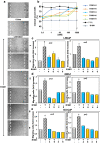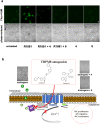Therapeutic potential of TRPM8 antagonists in prostate cancer
- PMID: 34853378
- PMCID: PMC8636514
- DOI: 10.1038/s41598-021-02675-4
Therapeutic potential of TRPM8 antagonists in prostate cancer
Abstract
Transient receptor potential melastatin-8 (TRPM8) represents an emerging target in prostate cancer, although its mechanism of action remains unclear. Here, we have characterized and investigated the effects of TRPM8 modulators in prostate cancer aggressiveness disclosing the molecular mechanism underlying their biological activity. Patch-clamp and calcium fluorometric assays were used to characterize the synthesized compounds. Androgen-stimulated prostate cancer-derived cells were challenged with the compounds and the DNA synthesis was investigated in a preliminary screening. The most effective compounds were then employed to inhibit the pro-metastatic behavior of in various PC-derived cells, at different degree of malignancy. The effect of the compounds was then assayed in prostate cancer cell-derived 3D model and the molecular targets of selected compounds were lastly identified using transcriptional and non-transcriptional reporter assays. TRPM8 antagonists inhibit the androgen-dependent prostate cancer cell proliferation, migration and invasiveness. They are highly effective in reverting the androgen-induced increase in prostate cancer cell spheroid size. The compounds also revert the proliferation of castrate-resistant prostate cancer cells, provided they express the androgen receptor. In contrast, no effects were recorded in prostate cancer cells devoid of the receptor. Selected antagonists interfere in non-genomic androgen action and abolish the androgen-induced androgen receptor/TRPM8 complex assembly as well as the increase in intracellular calcium levels in prostate cancer cells. Our results shed light in the processes controlling prostate cancer progression and make the transient receptor potential melastatin-8 as a 'druggable' target in the androgen receptor-expressing prostate cancers.
© 2021. The Author(s).
Conflict of interest statement
The authors declare no competing interests.
Figures







Similar articles
-
New TRPM8 blockers exert anticancer activity over castration-resistant prostate cancer models.Eur J Med Chem. 2022 Aug 5;238:114435. doi: 10.1016/j.ejmech.2022.114435. Epub 2022 May 12. Eur J Med Chem. 2022. PMID: 35598411
-
TRPM8 channel as a novel molecular target in androgen-regulated prostate cancer cells.Oncotarget. 2015 Jul 10;6(19):17221-36. doi: 10.18632/oncotarget.3948. Oncotarget. 2015. PMID: 25980497 Free PMC article.
-
Tetrahydroisoquinoline-Derived Urea and 2,5-Diketopiperazine Derivatives as Selective Antagonists of the Transient Receptor Potential Melastatin 8 (TRPM8) Channel Receptor and Antiprostate Cancer Agents.J Med Chem. 2016 Jun 23;59(12):5661-83. doi: 10.1021/acs.jmedchem.5b01448. Epub 2016 Jun 14. J Med Chem. 2016. PMID: 27232526
-
TRPM8 in prostate cancer cells: a potential diagnostic and prognostic marker with a secretory function?Endocr Relat Cancer. 2006 Mar;13(1):27-38. doi: 10.1677/erc.1.01093. Endocr Relat Cancer. 2006. PMID: 16601277 Review.
-
TRPM8 biology and medicinal chemistry.Curr Top Med Chem. 2011;11(17):2237-52. doi: 10.2174/156802611796904933. Curr Top Med Chem. 2011. PMID: 21671871 Review.
Cited by
-
On the modulation of TRPM channels: Current perspectives and anticancer therapeutic implications.Front Oncol. 2023 Feb 9;12:1065935. doi: 10.3389/fonc.2022.1065935. eCollection 2022. Front Oncol. 2023. PMID: 36844925 Free PMC article. Review.
-
In Vitro and In Vivo Pharmacological Characterization of a Novel TRPM8 Inhibitor Chemotype Identified by Small-Scale Preclinical Screening.Int J Mol Sci. 2022 Feb 13;23(4):2070. doi: 10.3390/ijms23042070. Int J Mol Sci. 2022. PMID: 35216186 Free PMC article.
-
Filamin A cooperates with the androgen receptor in preventing skeletal muscle senescence.Cell Death Discov. 2023 Dec 2;9(1):437. doi: 10.1038/s41420-023-01737-y. Cell Death Discov. 2023. PMID: 38040692 Free PMC article.
-
Editorial: March 2022: Ovarian and prostate cancer awareness month.Front Endocrinol (Lausanne). 2023 Feb 13;14:1133963. doi: 10.3389/fendo.2023.1133963. eCollection 2023. Front Endocrinol (Lausanne). 2023. PMID: 36860370 Free PMC article. No abstract available.
-
TRPM8 protein dynamics correlates with ligand structure and cellular function.bioRxiv [Preprint]. 2025 May 15:2025.05.13.653789. doi: 10.1101/2025.05.13.653789. bioRxiv. 2025. Update in: J Am Chem Soc. 2025 Jun 4;147(22):18460-18474. doi: 10.1021/jacs.4c09435. PMID: 40463232 Free PMC article. Updated. Preprint.
References
Publication types
MeSH terms
Substances
LinkOut - more resources
Full Text Sources
Medical

